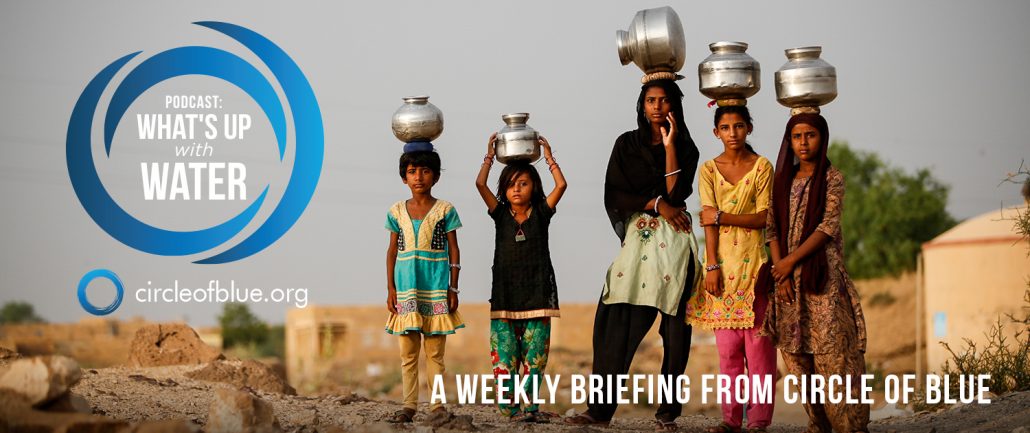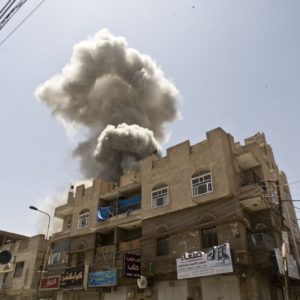
This week’s edition of What’s Up With Water includes coverage on:
- Flash floods in Somalia
- Rising dam levels in Cape Town
- Water stress in Los Angeles, California
- The impact of deforestation on water supply in Melbourne, Australia
Transcripts
I’m Eileen Wray-McCann, for Circle of Blue, and here’s What’s up with Water, a condensation of the world’s water news.
Mere months after a devastating drought, Somalia has been overwhelmed by flash floods, some of the worst seen in decades.
The United Nations reports that the flooding affects nearly half a million people. Displaced persons camps in low-lying areas are the most vulnerable to the rising waters.
The heavy rains and flash floods over large parts of the country are much worse than had been predicted. They are a stark contrast to the severe drought Somalia faced only months ago, which made over six million people dependent on humanitarian relief.
Last week, Somalia’s President, Mohamed Abdullahi Farmajo, toured affected areas and urged the international community to help. Somalia’s Humanitarian Response Plan for 2018 is only 19 percent funded, although a UN official says that that relief agencies have raised funds for food, water, sanitation, and medicine.
In South Africa, Cape Town is seeing a small increase in water reserves for the first time since October 2017.
During the worst drought on record, residents faced “Day Zero,” the date on which the water taps would run dry for most businesses and industry. Stringent water conservation made the remaining water last until the rainy season, pushing Day Zero off the calendar for 2018.
The restrictions are still in effect, water use is holding steady, and the rains are filling catchment areas for the dams. Total storage rose nearly one percent in the past week, according to Cape Town’s website.
In Australia, ecologists say that Melbourne’s water supply is threatened by damage to mountain ash forests in the headwaters of the city’s catchment. Researchers at the Australian National University had warned the government that decades of logging and brush fires could cause the collapse of the forest ecosystem.
New research shows that damage is already occurring, and even without more logging or fires, collapse is probably unavoidable. Changes in the tree communities will alter the complex and fragile natural water collection system supplying Melbourne’s 4.5 million residents.
The key to the ecosystem is the population of older, larger trees, which sustain many species. When old-growth trees disappear, plants and animals soon follow. The study says that the Mountain Ash forests have lost half their large old trees over the past twenty years. And in that time, populations of animals in these forests have dwindled to at least half their former numbers.
It would take 50 years for younger ash trees to grow enough to replace their elders. In that time the ecosystem could shift, with the rise of a new dominant species such as the Acacia shrub.
Young ash trees and acacia bushes require much more water than old-growth trees. This has profound implications for Melbourne’s water supply, most of which comes from mountain ash forests where few old-growth trees remain. In the catchment for Melbourne’s largest water supply dam, about 61% of the trees have been logged.
The head author of the university study said that the value of the water entering the water catchments is about 25 times higher than the value of the timber cut from those same catchments. He urges major changes to forest policy, with greater protection for the old-growth trees.
Indonesia’s Citarum River is one of the most polluted in the world, according to an investigative documentary released last week by Al Jazeera.
The Citarum has long been the heart of life in West Java, for fishing, irrigation, and the domestic needs of millions of people living along its banks.
But the textile industry moved in, and the fish are gone now. In their place are endless streams of plastic debris. The water has become toxic – sometimes red, sometimes black, sometimes frothy and often foul. This water feeds the fields of rice that bear a toxic load to families throughout Indonesia.
About 500 textile plants border the Citarum River, some operating around the clock. Al Jazeera’s interviews and laboratory testing reveal the lax water quality standards at one factory and the dangers of the heavy metals, neurotoxins and endocrine-disruption chemicals released into the river, sometimes after dark.
In the documentary, a pollution control official at Indonesia’s Ministry of Environment is shown a laboratory data on water from the Citarum. He says he will ask for more testing and, if warranted, look into revising permits and guidelines for the textile companies. Al Jazeera notes the power of major brands in the industry to deter regulation, and says that textile production in Indonesia is expected to grow by 75% in the next 12 years in order to meet global demand.
In the United States, Los Angeles prepares for a new chapter in its storied relationship to water. In the past century aqueducts channeled the precious resource from the San Joaquin delta in the north, the Sierra Nevada mountains to the east and the Hoover Dam on the Colorado River. L.A. grew to be one of the world’s largest cities, with some 18 million people.
But climate change is reducing all three sources of water, and Mayor Eric Garcetti says the next phase of development is going to reflect a “new normal” of less water for more people. The question is how to achieve sustainability for the economy, and for life itself. He says that conservation is one answer, pointing to the successful efforts of residents during the recent drought, which lasted a number of years. Other solutions include water recycling and the capture of local rainwater.
“We have plenty of water in Los Angeles,” he says, “ It’s whether we choose to use it efficiently and effectively.”
And that’s What’s Up With Water…We’d like to share what’s up where you are – Tweet us with your water news: @circleofblue #whatsupwithwater.
Eileen Wray-McCann is a writer, director and narrator who co-founded Circle of Blue. During her 13 years at Interlochen Public Radio, a National Public Radio affiliate in Northern Michigan, Eileen produced and hosted regional and national programming. She’s won Telly Awards for her scriptwriting and documentary work, and her work with Circle of Blue follows many years of independent multimedia journalistic projects and a life-long love of the Great Lakes. She holds a BA and MA radio and television from the University of Detroit. Eileen is currently moonlighting as an audio archivist and enjoys traveling through time via sound.



